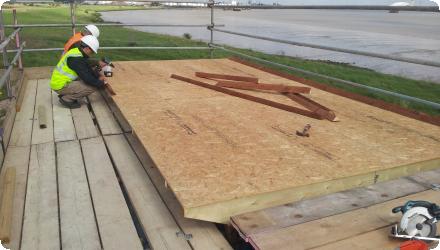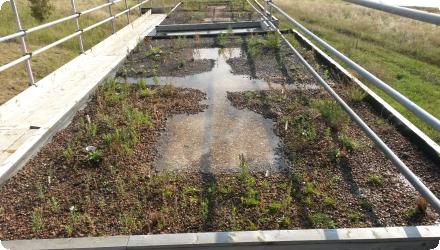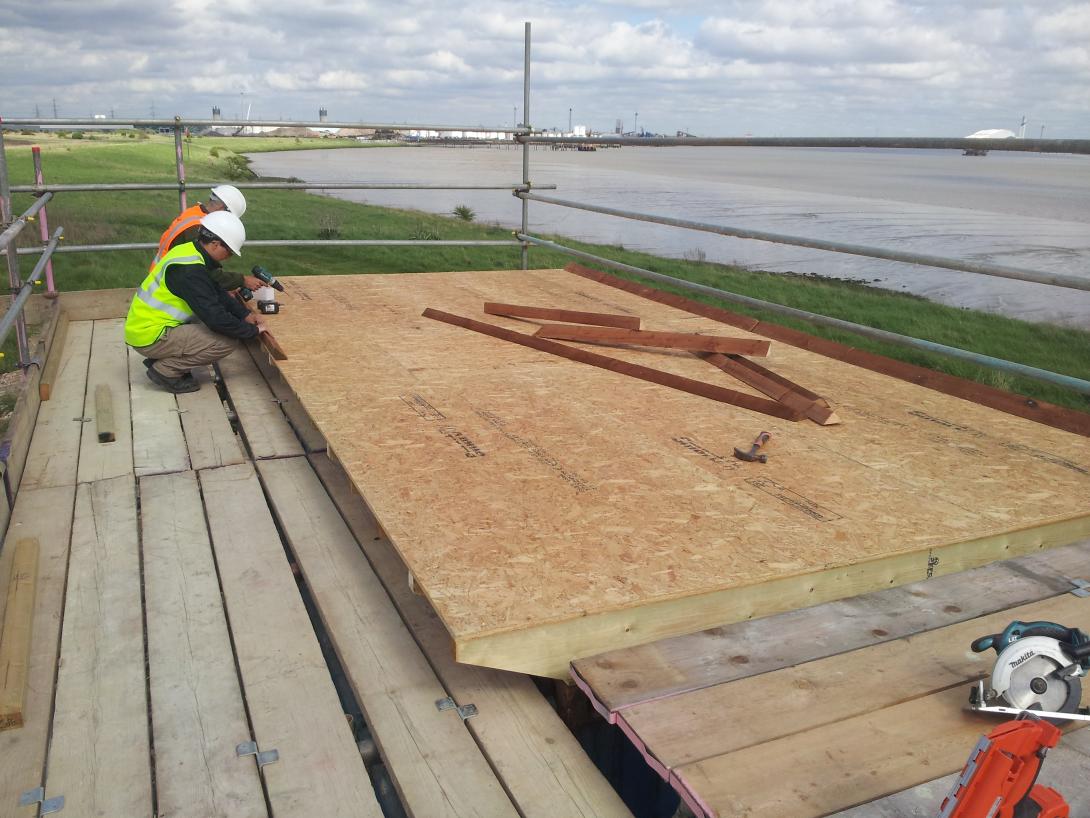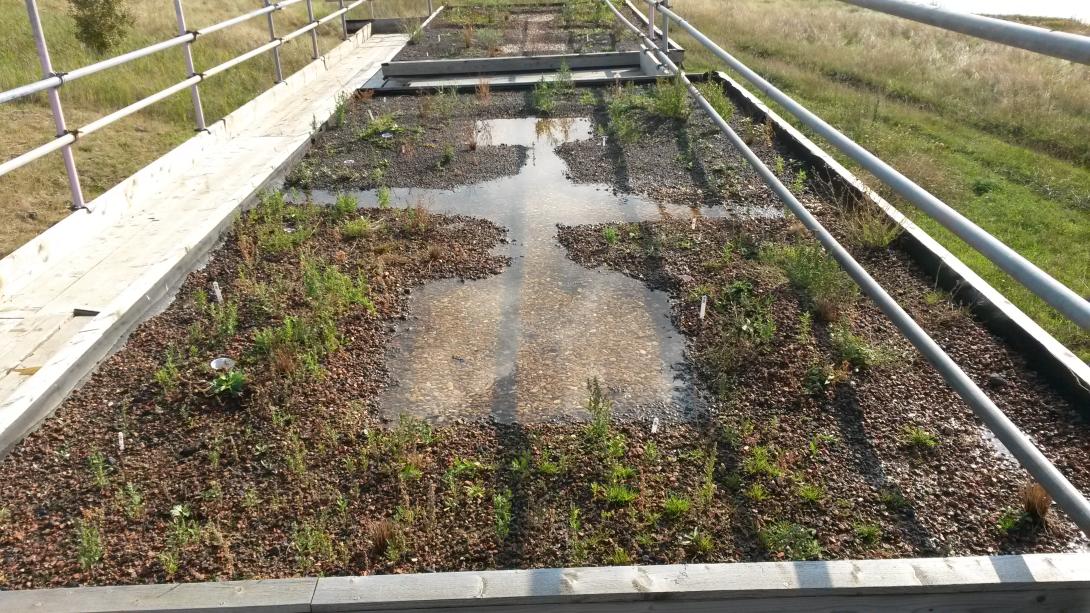Last update
2025
Summary
Barking Riverside piloted an ecomimicry approach to green roofs to conserve a regionally important brownfield invertebrate community, including target species such as the brown-banded carder bee (Bombus humilis) and Gymnosoma nitens. Roof test bays reproduced open-mosaic niches (varied substrate depths, recycled aggregates, ephemeral pools), and monitoring showed these designs could retain pre-development biodiversity while delivering connectivity and ecosystem services. Since then, the method has been formalised in guidance and peer-reviewed research and used to inform wider green infrastructure across the development. At borough scale, by end-2017 Barking & Dagenham hosted 51,658 m² of green roofs, with over 25,000 m² at Barking Riverside (nearly half the borough total), evidencing roll-out beyond the initial trials. Current planning documents continue to mandate ecologically sensitive roofs, with Stage 2 South (2023) targeting 40% of total roof area as green roofs and 10% as brown roofs, and the 2024 Local Plan reinforcing green/brown roofs and locally appropriate planting. Early delivery included ~50 homes (≈20 m² each) and a 2,100 m² roof (1,500 m² vegetated), preceding the broader programme.
Position
Latitude
51.520402
Longitude
0.118587
Project
NWRM
National Id
UK_7
Installation date
2013-2014
Implementation Status
Contact
Stuart Connop, Senior Research Fellow at UEL
RBD code
Thames
Transboundary
0
Photo gallery
Location of the project
Barking Riverside, London Borough of Barking & Dagenham, UK
Post-industrial brownfield site that supported important biodiversity now being redeveloped to provide 11,000 homes
Post-industrial brownfield site that supported important biodiversity now being redeveloped to provide 11,000 homes
NUTS Code
UKI2 - Outer London
Project's objectives
Create green roofs that support ≥53 invertebrate species including nationally rare taxa.
Achieve vegetation cover supporting >110 plant species, with spontaneous colonisation.
Retain stormwater up to 80 mm temporarily.
Match or exceed the water retention of standard sedum roofs.
Improve floral and faunal richness over two years of monitoring
Achieve vegetation cover supporting >110 plant species, with spontaneous colonisation.
Retain stormwater up to 80 mm temporarily.
Match or exceed the water retention of standard sedum roofs.
Improve floral and faunal richness over two years of monitoring
Involved Partners
| Authority type | Authority name | Role | Comments |
|---|---|---|---|
Climate zone
cool temperate moist
Temperature
11.0 °C
Annual rainfall range
900 - 1200 mm
Elevation range
6 m
Slope range
1-2%
Vegetation class
The vegetation mimics early successional brownfield habitats and includes both dry and wetland species. Examples: Lotus corniculatus, Leucanthemum vulgare, Juncus effusus, Lythrum salicaria, etc. This forms a diverse assemblage reflecting open mosaic habitats.
Water bodies: Ecological Status
Moderate
Water bodies: Chemical Status
Good
Water quality status
Tidal Thames around Barking: all water bodies fail chemical status; ecological potential mostly moderate. Key pressures: physical modifications, urban/transport diffuse pollution, and wastewater discharges.
Project scale
Micro
Project scale specification
The Barking Riverside development covers 443 acres, aiming to build 10,800 homes, schools, and infrastructure for 25,000 residents. Green infrastructure, including green roofs, is implemented across 40% of buildings and 40% of the land area.
Performance timescale
< 1 year
Project area
179
Area specifications
Total Barking Riverside development: 443 acres (~179 ha)
Green roofs installed on 40% of buildings (exact m² not specified)
Each test green roof: 6 × 3 m, with 9 test roofs in the experiment
Green roofs installed on 40% of buildings (exact m² not specified)
Each test green roof: 6 × 3 m, with 9 test roofs in the experiment
The project was based on the principle of ecomimicry—designing green roofs to mimic the ecological functions of the original brownfield Open Mosaic Habitat. It also followed principles of multifunctional green infrastructure, climate resilience, biodiversity conservation, and urban sustainability. The aim was to preserve ecosystem services and regional biodiversity, especially rare invertebrates, by replicating their natural habitats on roofs. Additionally, it integrated SuDS principles and promoted co-creation between scientists, developers, and planners.
Design capacity description
Three green roof treatments were created to test varying water retention capacities:
- Treatment 1: Free-draining standard green roof.
- Treatment 2: 40 mm raised drainage to hold water in the substrate.
- Treatment 3: 80 mm raised drainage to allow surface pooling.
Each roof had varied substrate depths and profiles to mimic habitat heterogeneity, enhancing stormwater retention and biodiversity. Drainage manipulation aimed to replicate ephemeral wetland features, increasing the range of conditions and niches for flora and fauna.
- Treatment 1: Free-draining standard green roof.
- Treatment 2: 40 mm raised drainage to hold water in the substrate.
- Treatment 3: 80 mm raised drainage to allow surface pooling.
Each roof had varied substrate depths and profiles to mimic habitat heterogeneity, enhancing stormwater retention and biodiversity. Drainage manipulation aimed to replicate ephemeral wetland features, increasing the range of conditions and niches for flora and fauna.
Potential risks include roof load-bearing capacity limitations due to added water and substrate, risk of waterproof membrane failure if water pooling systems fail, and possible drought stress during dry seasons without irrigation.
Pre-existing brownfield biodiversity and habitat diversity serving as ecomimicry templates.
No intensive vegetation management historically, enabling colonisation by rare species.
No intensive vegetation management historically, enabling colonisation by rare species.
Positive influence effectiveness
Pre-development brownfield conditions provided ecological templates with high water retention potential. Habitat mosaic and topographic variability promote micro-retention zones.
Negative influence effectiveness
Prolonged water exposure may impact the waterproofing membrane if not well-managed.
Total cost
unknown
Costs total information
Experimental setup (9 green roofs on containers): €45,000
PhD studentship (3 years): €70,000
PhD studentship (3 years): €70,000
Information on Economic costs - income loss
No income loss is reported. The green roofs were cost-comparable or cheaper than standard systems, and land use changes did not displace economic activity that would result in losses.
Financing authorities
Type of funding
EU-funds: LIFE+
Comments
FP7 TURAS €45,000 for experimental setup
Comments
€70,000 PhD funding
Compensations
0
Policy context
Mitigates habitat loss from urbanisation and stormwater runoff impacts. Also addresses urban biodiversity fragmentation and ecosystem service degradation.
Land ownership
Barking Riverside Limited (BRL) holds the site freehold.
Community involvment
No
Design consultation activity
| Activity stage | Name | Key issues | Comments |
|---|
Policy target
| Target purpose |
|---|
|
Improved Biodiversity
|
|
Runoff control
|
|
Increase Water Storage
|
|
Oher Societal Benefits
|
Target Remarks
The design was multifunctional, embedding ecomimicry to mimic the regionally important habitats and their services. Biodiversity and runoff control were equally emphasized, with novel drainage designs enabling enhanced habitat variety and hydrological performance.
Policy pressure
| Pressure directive | Relevant pressure |
|---|---|
|
WFD identified pressure
|
Pressure from urban development and hydromorphological changes.
|
|
WFD identified pressure
|
Risk of pluvial and fluvial flooding in urbanised London.
|
|
Other non-EU
|
Biodiversity Strategy for England & UK BAP: Protection of Open Mosaic Habitat.
|
Pressures remarks
Policy pressures shaped both the functional goals (flood mitigation, biodiversity conservation) and procedural requirements (e.g. planning consent mandates) for the project.
Policy impact
| Impact directive | Relevant impact |
|---|---|
|
WFD identified impact
|
Supports better ecological status through diffuse pollution mitigation.
|
|
Floods Directive identified impact
|
Reduced runoff volumes and flood risk.
|
|
Other non-EU
|
UK Biodiversity Action Plan: Mitigation for loss of Open Mosaic Habitat.
|
|
Other non-EU
|
Climate Adaptation Policy: Contributes to urban cooling and water retention.
|
Impact remarks
The project responds to multiple interconnected goals across scales—local planning, national biodiversity priorities, and EU-wide GI strategies. It shows synergy in responding to multiple policy drivers simultaneously.
Requirement directive
| Requirement directive | Specification |
|---|---|
|
WFD-mitigation of significant pressure
|
Urban runoff
|
|
Floods Directive-mitigating Flood Risk
|
Contractual arrangements
0
| Arrangement type | Responsibility | Role | Name | Comments |
|---|
Part of wider plan
1
Wider plan type
| Wider plan type | Wider plan focus | Name | Comments |
|---|---|---|---|
|
National
|
Urban
|
National Planning Policy Framework (UK)
|
Urban regeneration & brownfield reuse.
|
|
Regional
|
Urban
|
London Plan
|
Regional policy for sustainable development and green infrastructure.
|
|
Urban
|
TURAS FP7
|
EU-funded urban sustainability programme.
|
Plant diversity and structure via quadrats and transects.
Invertebrate community composition using pitfall traps.
Seasonal and spatial variation in vegetation development.
Invertebrate community composition using pitfall traps.
Seasonal and spatial variation in vegetation development.
Maintenance
Minimal. The biodiverse green roofs were designed to reduce management requirements compared to traditional landscaping. The use of drought-tolerant species and design that limits the need for irrigation or fertilization supports low-maintenance operation
The design compared three roof treatments with different drainage configurations to study biodiversity outcomes and hydrological dynamics.
Botanical and invertebrate surveys, habitat mapping, species richness/evenness calculations, and seasonal variation monitoring were used.
No formal cost assessment methodology is described beyond mentioning comparable costs to standard systems.
Reduced construction costs: Green roofs cost less than standard sedum roofs due to removal of drainage layers.
Improved local microclimate: Urban cooling benefits from increased evapotranspiration.
Compliance with planning conditions: Enabled development approval.
Research and innovation opportunities: Hosted PhDs and research funding.
Local engagement: Enhanced community value through aesthetic and nature-connected spaces.
Improved local microclimate: Urban cooling benefits from increased evapotranspiration.
Compliance with planning conditions: Enabled development approval.
Research and innovation opportunities: Hosted PhDs and research funding.
Local engagement: Enhanced community value through aesthetic and nature-connected spaces.
Supports climate change adaptation (stormwater buffering, cooling).
Increases habitat connectivity for urban biodiversity.
Raises awareness and engagement around nature in urban development.
Enhances academic-practice partnerships and supports educational use.
Increases habitat connectivity for urban biodiversity.
Raises awareness and engagement around nature in urban development.
Enhances academic-practice partnerships and supports educational use.
Hydrological effects
Slows down stormwater runoff using substrate saturation and surface pooling, enhances water retention at roof level, promotes evapotranspiration, reduces immediate runoff into SuDS infrastructure.
Information on retained water
Treatment 3 retained up to 80 mm of rainwater temporarily via elevated drainage.
Roofs retained water in substrate and surface pools. Geotextiles at base also held and gradually released water.
Roofs retained water in substrate and surface pools. Geotextiles at base also held and gradually released water.
Information on runoff reduction
Ecomimicry roofs matched or outperformed standard sedum roofs in stormwater attenuation, with slower drainage from pooled designs.
Water quality overall improvements
N/A info
Information on Water quality overall improvements
Water quality effects are likely positive due to filtration by substrate and retention of pollutants in runoff, but no empirical water quality measurements are reported for Barking Riverside.
Information on Soil quality overall soil improvements
No evidence of soil pollution reduction or carbon storage, but soil-like substrates were ecologically functional.
Information on Soil quality overall soil nutrients
Substrates were designed using low-nutrient aggregates to mimic brownfield soils, aiming to limit nutrient loading and support high biodiversity.
Information on Soil quality, overall soil physical properties
Physical properties such as friability and heterogeneity were intentionally recreated using PFA and recycled materials to support early successional species.
1
Habitat creation: Mimics ephemeral wetland, ruderal, and scrub habitats.
Plant species: 114 species recorded (36 planted, 78 spontaneously colonised). Many colonisers were characteristic of high-quality brownfield sites.
Invertebrates: 53 species recorded, including Scybalicus oblongiusculus (RDB1), Bombus humilis (UKBAP), and Lasioglossum pauperatum (RDB3).
Community benefits: Created habitat heterogeneity with mounds, wet and dry areas, and bare ground, supporting a wide range of taxa.
Soil fauna and benthos: Not assessed due to rooftop context, but surface biodiversity was strong.
This confirms the effectiveness of ecomimicry for rare and conservation-priority species.
Plant species: 114 species recorded (36 planted, 78 spontaneously colonised). Many colonisers were characteristic of high-quality brownfield sites.
Invertebrates: 53 species recorded, including Scybalicus oblongiusculus (RDB1), Bombus humilis (UKBAP), and Lasioglossum pauperatum (RDB3).
Community benefits: Created habitat heterogeneity with mounds, wet and dry areas, and bare ground, supporting a wide range of taxa.
Soil fauna and benthos: Not assessed due to rooftop context, but surface biodiversity was strong.
This confirms the effectiveness of ecomimicry for rare and conservation-priority species.
Information on Ecosystem impact climate regulation
Thermal insulation benefits were observed. Biodiverse roofs performed as well or better than standard sedum roofs in reducing building heat gain and promoting urban cooling through evapotranspiration, contributing to climate regulation
Information on Increased Evapotranspiration
Evapotranspiration increased due to the use of deeper and moisture-retentive substrates. However, there is no quantified data.
Information on Mitigation other biophysical impacts
Thermal insulation improvement, reducing urban heat island effects.
Habitat connectivity at roof level, acting as a “stepping stone” for species movement.
Microtopography impacts (mounds, slopes, depressions) enhanced diversity of niches.
Habitat connectivity at roof level, acting as a “stepping stone” for species movement.
Microtopography impacts (mounds, slopes, depressions) enhanced diversity of niches.
Information on Ecosystem provisioning services
No provisioning services like food or fuel were added. The land is residential/commercial.
Key lessons
Ecomimicry successfully replicated brownfield habitats on green roofs. Design must include microhabitat diversity and local ecological knowledge. Pooling design can be integrated without damaging the waterproof membrane. Industry standardisation limits biodiversity; flexibility and co-creation improve outcomes.Long-term monitoring is needed, but even short-term results showed high colonisation.
The partnership model between academia, developers, and public bodies was crucial.
The partnership model between academia, developers, and public bodies was crucial.
Success factor(s)
| Success factor type | Success factor role | Comments | Order |
|---|---|---|---|
|
Attitude of relevant stakeholders
|
main factor
|
Positive, with collaborative engagement. |
1
|
|
Available support tools
|
secondary factor
|
TURAS FP7 provided structure. |
2
|
Driver
| Driver type | Driver role | Comments | Order |
|---|
Flexibility adaptability
Roof design allowed for variable drainage depths and substrate types.
Design adapted over phases to improve habitat simulation.
The system could revert to standard green roof function if pooling layer failed.
The project was designed to be context-sensitive, allowing other regions to adapt similar principles to different habitats.
Design adapted over phases to improve habitat simulation.
The system could revert to standard green roof function if pooling layer failed.
The project was designed to be context-sensitive, allowing other regions to adapt similar principles to different habitats.
Transferability
Transferable Elements:
- The ecomimicry approach (using local habitat templates) is universally applicable.
- Modular roof design adaptable to different species and substrates.
Challenges:
- Requires site-specific ecological knowledge and design expertise.
- Architects may resist standing water unless managed carefully.
- Must ensure drainage does not compromise roofing infrastructure.
Opportunities:
- Suited to urban redevelopment with biodiversity goals.
- Strong potential where brownfield land is being lost
- The ecomimicry approach (using local habitat templates) is universally applicable.
- Modular roof design adaptable to different species and substrates.
Challenges:
- Requires site-specific ecological knowledge and design expertise.
- Architects may resist standing water unless managed carefully.
- Must ensure drainage does not compromise roofing infrastructure.
Opportunities:
- Suited to urban redevelopment with biodiversity goals.
- Strong potential where brownfield land is being lost
Cost effectiveness
Biodiverse green roofs were found to be as cost-effective, or even cheaper, than industry-standard sedum systems. They provided additional ecological benefits without increasing construction costs due to elimination of separate drainage layers.
English



